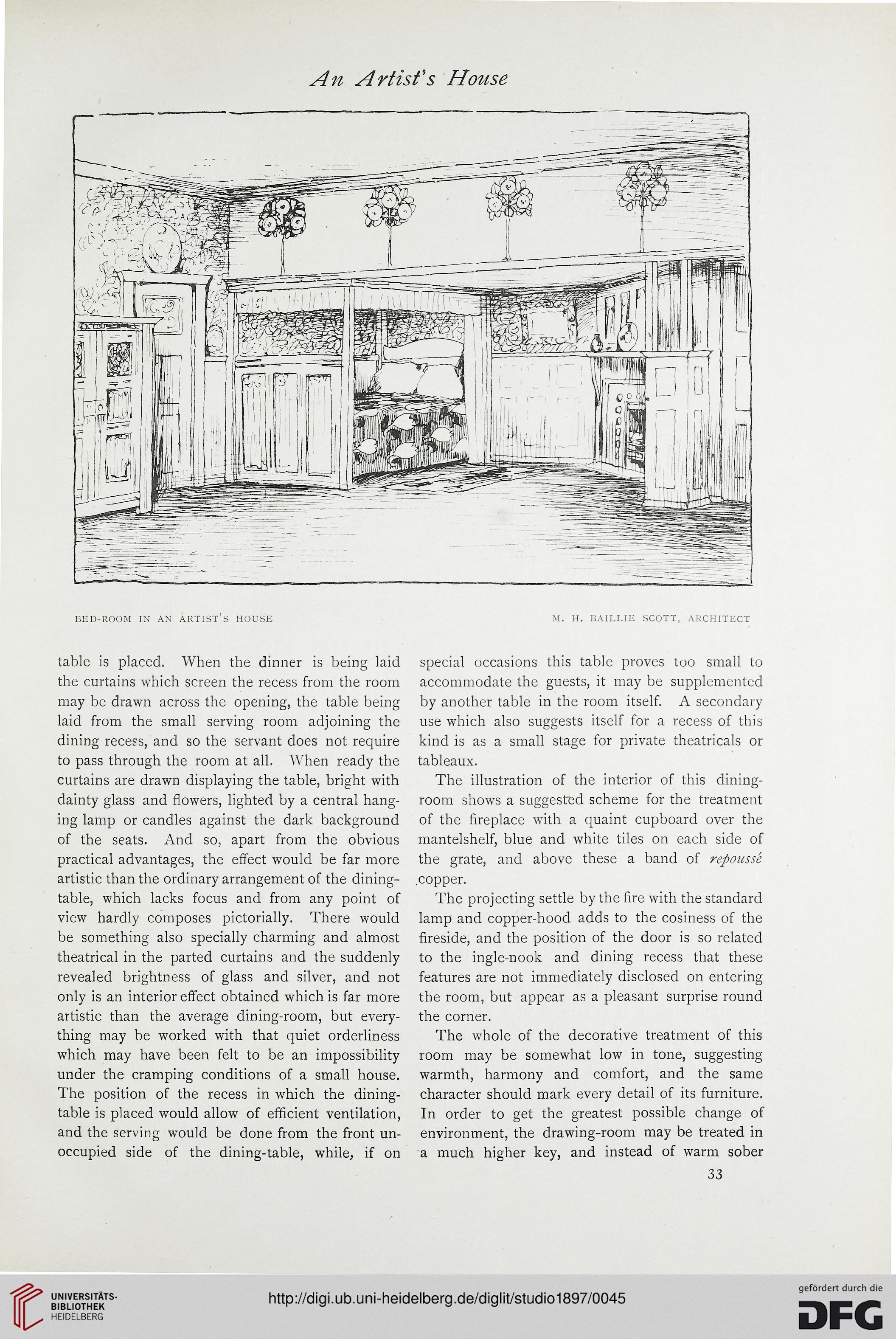An Artisfs House
BED-ROOM IN AN ARTIST'S HOUSE M. H. BA1LLIE SCOTT, ARCHITECT
table is placed. When the dinner is being laid
the curtains which screen the recess from the room
may be drawn across the opening, the table being
laid from the small serving room adjoining the
dining recess, and so the servant does not require
to pass through the room at all. When ready the
curtains are drawn displaying the table, bright with
dainty glass and flowers, lighted by a central hang-
ing lamp or candles against the dark background
of the seats. And so, apart from the obvious
practical advantages, the effect would be far more
artistic than the ordinary arrangement of the dining-
table, which lacks focus and from any point of
view hardly composes pictorially. There would
be something also specially charming and almost
theatrical in the parted curtains and the suddenly
revealed brightness of glass and silver, and not
only is an interior effect obtained which is far more
artistic than the average dining-room, but every-
thing may be worked with that quiet orderliness
which may have been felt to be an impossibility
under the cramping conditions of a small house.
The position of the recess in which the dining-
table is placed would allow of efficient ventilation,
and the serving would be done from the front un-
occupied side of the dining-table, while, if on
special occasions this table proves too small to
accommodate the guests, it may be supplemented
by another table in the room itself. A secondary
use which also suggests itself for a recess of this
kind is as a small stage for private theatricals or
tableaux.
The illustration of the interior of this dining-
room shows a suggested scheme for the treatment
of the fireplace wTith a quaint cupboard over the
mantelshelf, blue and white tiles on each side of
the grate, and above these a band of repousse
copper.
The projecting settle by the fire with the standard
lamp and copper-hood adds to the cosiness of the
fireside, and the position of the door is so related
to the ingle-nook and dining recess that these
features are not immediately disclosed on entering
the room, but appear as a pleasant surprise round
the corner.
The whole of the decorative treatment of this
room may be somewhat low in tone, suggesting
warmth, harmony and comfort, and the same
character should mark every detail of its furniture.
In order to get the greatest possible change of
environment, the drawing-room may be treated in
a much higher key, and instead of warm sober
33
BED-ROOM IN AN ARTIST'S HOUSE M. H. BA1LLIE SCOTT, ARCHITECT
table is placed. When the dinner is being laid
the curtains which screen the recess from the room
may be drawn across the opening, the table being
laid from the small serving room adjoining the
dining recess, and so the servant does not require
to pass through the room at all. When ready the
curtains are drawn displaying the table, bright with
dainty glass and flowers, lighted by a central hang-
ing lamp or candles against the dark background
of the seats. And so, apart from the obvious
practical advantages, the effect would be far more
artistic than the ordinary arrangement of the dining-
table, which lacks focus and from any point of
view hardly composes pictorially. There would
be something also specially charming and almost
theatrical in the parted curtains and the suddenly
revealed brightness of glass and silver, and not
only is an interior effect obtained which is far more
artistic than the average dining-room, but every-
thing may be worked with that quiet orderliness
which may have been felt to be an impossibility
under the cramping conditions of a small house.
The position of the recess in which the dining-
table is placed would allow of efficient ventilation,
and the serving would be done from the front un-
occupied side of the dining-table, while, if on
special occasions this table proves too small to
accommodate the guests, it may be supplemented
by another table in the room itself. A secondary
use which also suggests itself for a recess of this
kind is as a small stage for private theatricals or
tableaux.
The illustration of the interior of this dining-
room shows a suggested scheme for the treatment
of the fireplace wTith a quaint cupboard over the
mantelshelf, blue and white tiles on each side of
the grate, and above these a band of repousse
copper.
The projecting settle by the fire with the standard
lamp and copper-hood adds to the cosiness of the
fireside, and the position of the door is so related
to the ingle-nook and dining recess that these
features are not immediately disclosed on entering
the room, but appear as a pleasant surprise round
the corner.
The whole of the decorative treatment of this
room may be somewhat low in tone, suggesting
warmth, harmony and comfort, and the same
character should mark every detail of its furniture.
In order to get the greatest possible change of
environment, the drawing-room may be treated in
a much higher key, and instead of warm sober
33




